Table of contents
- Out and about with the motorcycle Island hopping in Indonesia
- Indonesia: pearls in the ocean
- Island hopping in Indonesia
- Indonesia: the flower island
- Indonesia – information
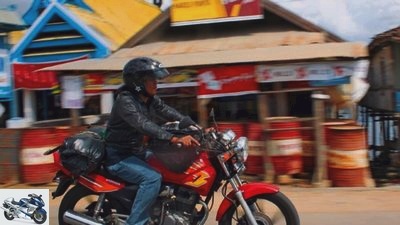
Blacksmith
to travel
On the way: Indonesia
Out and about with the motorcycle
Island hopping in Indonesia
Five islands, three religions, a huge experience – everything is different in Indonesia: flora, fauna and traffic. Diverse cultures, wonderful landscapes and a colorful life beckon.
Thomas Schmieder
December 3, 2009
Indonesia: pearls in the ocean
Buy complete article
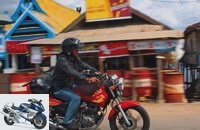
Out and about with the motorcycle
Island hopping in Indonesia
8 pages) as PDF
€ 2.00
Buy now
The most important traffic rule: avoid impending collisions at lightning speed and ideally honk at the same time. Anyone who dares is right, that’s it. If it’s not enough, things go round; because almost all private vehicles are not insured. In the event of damage, there is free negotiation, with great nagging and sympathy from the whole village. And when things get really tough, the Hindu belief in rebirth remains: More than 95 percent of the Balinese belong to the Hindu Dharma belief, which teaches the harmony of people as well as harmony with nature and the gods. Faith seems to provide enlightenment; because nobody switches on their vehicle lights until it is completely dark. “light?”, Wayan asks incredulously. “That just irritates us”.
And that in the tropics, where the sun suddenly plunges into the sea at dusk and the night lasts twelve hours. We spend the night in a hotel directly on the beach in Padangbai in the east of Bali. The next morning we screw our way up the mountains over the smallest bends and reach the top of the pass at 1640 meters. The Tiger chassis is extremely handy and astonishingly comfortable, the Single is quite powerful over 6000 rpm.
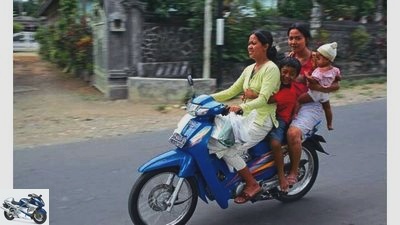
Blacksmith
Unhelmeted two-wheelers in Indonesia.
Four or five people together on one of the popular single-cylinder small motorcycles are not uncommon. Or sacks of rice. Or live pigs. In the original part of Bali, outside the touristy south, life is hard for the people. There is high unemployment and low wages here. As we drive past them, people wave enthusiastically. No luxury, no consumer goods, but plenty of cordiality. Our motorcycles are cultural door openers, because we move like the absolute majority of the population.
Culture shock in Ubud, art and tourist kitsch. Narrow, winding streets, a lack of parking spaces for motorbikes and a host of holidaymakers. We flee to the monkey forest, where we are surrounded by curious long-tailed macaques. They are considered sacred, rummage through our camera bags and demand food. In the evening we visit a traditional Kecak dance. More than 100 men and several graceful women represent the fight of good against evil in rousing choreography. Really impressive, this culture. This also applies to religion. There are nine main temples in Bali, but tens of thousands of ceremonial places. Something is celebrated every day.
Bahasa Indonesian is a very lively language to our ears, sounds like a mixture of Finnish and Dutch. Sure, the Netherlands was a colonial power until 1949. Exhaust means here “Knalpot”. The words we are familiar with? “Bami” and “Nasi Goreng, fried noodles and fried rice. It’s cheap and good at every corner from mobile cookshops, the warungs. Everyone asks two questions: “Darimana?” (Where are you from?) And “Mau ke mana?” (Where do you want to go?). Our answer: by ship to the east, to the neighboring island of Lombok.
Island hopping in Indonesia
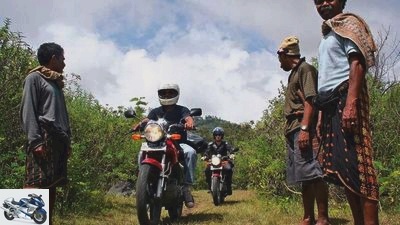
Blacksmith
Visiting the Ngada men.
When boarding the ferry we see delicate corals in the crystal clear water up to the beach and colorful, bizarre fish. We park the motorbikes in oil-smeared niches in the belly of the ship. Goats grumble on the loading deck, and women farmers spread their fruits. Melly, a 22 year old Muslim woman, sells “Salak”, delicious snake fruits. You have to throw hygienic standards completely overboard here. The boat is of a holey consistency. A soul seller? Don’t worry, say the Indonesians who sell water, fruit and cigarettes on board. Of course, every now and then a ferry goes under. But the last sinking was eight months ago…
Lombok welcomes us differently than Bali. The people are poorer. Huts are across from luxury hotels on the beach. The first of many mosques is not long in coming, the muezzin loudly calls out to prayer. And remembering being in a Muslim country. Horse-drawn vehicles determine the streetscape in some cities. The women wear headscarves, but they are not veiled and even give us unbelievers a smile.
“Crazy Road” is the name of the coastal road in the north of Lombok. A roller coaster by the sea. Often the asphalt turns abruptly by 90 degrees behind a hilltop or in a depression. A north loop in the tropics, just more picturesque and at a moderate pace. On the left is the Indian Ocean, on the right steep mountains tower up. We pass coconut palms on the beach, banana trees, drive through 20 meter high bamboo groves. Bamboo is good for scaffolding, house walls and guard rails in the jungle. Or for boats, water pipes and furniture. The plant of 1000 possibilities. Farmers stand in the rice fields. Straw hats on their heads, they cultivate Asia’s green gold. In more remote regions, the arrival of our five tigers is a sensation. People stand with their mouths open, students storm out of class. The tiger, which costs the equivalent of 1,800 euros (spoken “Tiggarrr”) every child here knows. Children are almost always the first to bridge the distance. Digital photos help us to build bridges. People feel honored when they see their likeness on the monitor.
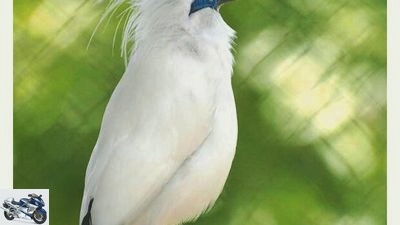
Blacksmith
Only a few couples still live from the beautiful Bali star.
Another ferry spits us out: on Sumbawa. Mangrove forests grow here on the coast, with finely branched roots. In the first village there are blue, colorful fishermen’s houses on stilts. In contrast, the city of Sumbawa Besar, the former sultan’s city, is busy and loud. “Do you have a wife? Asks Nurhayati, the hotel’s 24-year-old receptionist. The answer “No, not yet, she can’t believe it. The main street of Sumbawa is littered with crater-deep potholes in some sections. A water buffalo could bathe in it. It would be a great enduro area, but strangely enough, there are no XTs, XLs or DRs. Fortunately, our tigers also circle around obstacles of all kinds with ease. And carry us safely to Sape, the port city in the east. In traditional shipyards, it takes two people a month to build a ten to 15 meter long fishing boat. Its wooden planks are attached with wooden pins and sealed with tree bark.
On the island of Rinja in the Komodo National Park, dragons are waiting for us. 1200 Komodo dragons up to three meters long live here. You can only move around in the company of a ranger. Ours is called Kefi, is in his mid-twenties. He doesn’t protect the monitor lizards from us, but the other way round; because the bite of a Komodo dragon ends deadly and painfully. The saliva of the animals contains bacteria that cause incurable gangrene and blood poisoning. The monitor lolls almost motionless in the shade. Their prey does not run away from them. Water buffalo, significantly larger than the lizards themselves, which only have two weeks to live after a bite.
Indonesia: the flower island
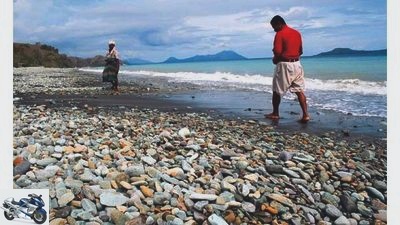
Blacksmith
Picturesque: the beach with the blue stones, near the village Ende on Flores.
Flores, the flower island. Millions of years ago the mountains pushed themselves out of the earth’s interior, spewed out by volcanoes, frozen in the air, in the most bizarre colors and shapes. From bright red to deep black. Pointed and rugged, then rounded and lovely. On the other hand, the sea rolls in incessantly, white spray over a turquoise blue ground. Vegetation and weather change dramatically in the rainforest. The different types of trees and plants are wonderfully nested into one another to form a huge 3D puzzle, the forest evaporates moisture. The rainy season comes early this year. the “Trans-Flores Highway”, the only west-east connection on the Catholic island has turned into a nasty mud and clay slope. Our tigers bravely fight their way through knee-deep water furrows. An important bridge became impassable, trucks and cars are standing across in the loamy soil. Only the two-wheelers get through, are pulled up the slippery slope with combined forces. Well, go.
It’s going to be adventurous. Thick boulders lie on the winding road through the jungle. They must have come down last night. Later, highwaymen collect for free travel. On the first morning in the hotel there is no water, on the second there is no electricity. We can watch the electricity pylon tilt, undermined by the water. Our power pole. So candles are all the rage. Yesterday we had deep blue skies and 35 degrees. Today we are wet and cold. In the middle of the tropics. It goes on, then a piece of glass tears open the hind paw of one of our tigers. We can repair the tire on site. Truck drivers next to us change their wheel bearings, right on the road.
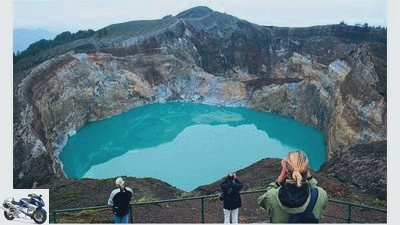
Blacksmith
Three different colored crater lakes of Mount Kelimutu on Flores are spectacular.
In the Manggarai village, Catholic icons stand in the middle of the jungle. The rice terraces are laid out like huge spider webs; every family cultivates a piece of cake. The aroma of cloves and cinnamon, vanilla and coffee is in the air. Papayas and mangoes grow right in front of the house entrances. An overwhelming variety. Suddenly a steamroller is on the runway; Workers cook tar in old oil drums for the Trans-Flores Highway. Road construction is manual work. Again and again gaps, unsecured slopes. Goats, bunches of bananas and people travel on the roofs of the overcrowded minibuses (bemos).
At the end of the place lies the “Blue Stone Beach”. The blue stones of the black lava dream beach serve as a coveted ornament for gardens and aquariums around the world. The crater lakes of the Kelimutu volcano also glow in color. Depending on the mineral content of the water, turquoise, brown and dark green, but also sometimes dark red, light blue and light green. No wonder that this panorama became an important place for rituals: the souls of the deceased are said to rest in these holy waters. And we rest in ourselves after this fantastic journey.
Indonesia – information
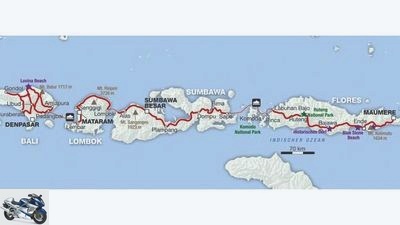
BILLION
Island hopping in Indonesia. Travel time: 14 days – Distance covered: 1500 kilometers.
INFO
Indonesia is the country with the largest population of Muslims and the largest island nation in the world: 17,500 islands on both sides of the equator, of which 6,000 are inhabited, stretch over 5,000 kilometers.
Capital city: Jakarta
Surface: 1912,988 km2
Founding: 1949
Currency: Rupiah
Population: 240 million.
GENERALLY
Indonesia’s climate is tropical and warm, cultures and prevailing religions vary depending on the island: Hinduism dominates Bali, Lombok and Sumbawa are predominantly Muslim and Flores are Roman Catholic. The national language is Bahasa Indonesia. There are also numerous regional languages. English is the language of business. Bali has an area of 5561 km2 and a population of 3.3 million; the north-south extension is 95 kilometers, from east to west it is a maximum of 145 km. The Gunung Agung volcano is the highest mountain on the island at 3,031 meters. Info: www.bali-info.de and www.insel-der-goetter.de.
GETTING THERE
Flights to Bali cost between 850 and 1300 euros, depending on the season. To enter Indonesia requires a visa, which is as “Visa on arrival” for 25 US dollars (17 euros) at the airport (valid for 30 days). The passport must be valid for at least six months upon entry.
STAY
There are (luxury) hotels in abundance on the tourist island of Bali, but the south is completely overrun with tourists. So it is better to move to the center of the island, to the north or east. This is an affordable dream hotel in Ubud “Artini 3 cottages” (www.artinicottage.com, double rooms from 40 US dollars / 27 euros). In Padangbai, the ferry port to Lombok with a great beach and heavenly diving areas, the Hotel Puri Rai (www.puriraihotel.com, double rooms from 31 US dollars / 21 euros) is a fine place to stay. The noble Hotel Rambutan awaits you in Lovina Beach (www.rambutan.org, double rooms from 50 US dollars / 34 euros). Lombok also has a very good infrastructure; from Sumbawa, hotels become sparser.
MONEY
100 euros is 1.4 million Indonesian rupees. That’s how quickly you become a millionaire!
CLOTHING / LUGGAGE
Take airy summer clothes with you or buy them cheaply on site (T-shirts). Highly recommended for motorcycle tours: Protector jeans, light textile jacket, short boots or high hiking boots, thin gloves. When there are showers, the pelerines, popular in Bali, help to pull over them. Secure luggage with lashing straps or luggage spider.
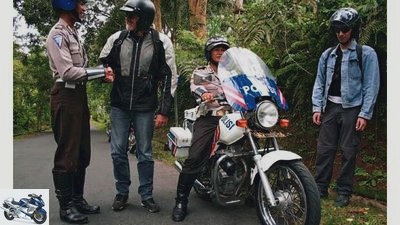
Blacksmith
Encounter on Bali with friendly motorcycle policemen.
RENT A MOTORBIKE
There are motorcycle rental companies in tourist metropolises in the south of Bali (Kuta); a 125cc costs from around five euros per day, the 200cc Honda Tiger around ten euros per day. Important: Thoroughly check the papers and technical condition of the rental machine. Liability insurance is unknown; if desired, take out additional insurance for rental vehicles in Germany (ADAC). The international driving license is compulsory. Petrol costs around 50 cents / liter, and the supply is widespread in Bali; In remote areas there are no regular petrol stations, but rather small stalls with fuel in canisters and plastic bottles – recognizable by the sign “Premium.”
GUIDED TOURS
Left-hand traffic and high traffic density require a lot of concentration. Therefore, local tour guides and advisors are recommended. Just a great guy: the English-speaking Wayan Joker, phone: 0062/81338775198. Windlooper offers guided tours with all-round service. A 15-day trip to Bali (March and October 2010) costs € 2,495 including flights, hotels and a rental motorcycle. The 21-day Flores tour (October 29-21, 2010) for 3695 euros also includes domestic flights and a week’s bathing holiday in Bali. Info: Telephone 04941/964513 www.windlooper.de.
LITERATURE
Recommended in English: The volumes “Bali” as “Indonesia” from the Lonely Planet series. The travel guide offers detailed German information “Bali & Lombok” (22.50 euros) from Reise Know how Verlag. That was also there “gibberish”-Language guide Indonesian (7.90 euros). Compact and inexpensive: the ADAC travel guide to Bali & Lombok (6.50 euros) and the counterpart by Marco Polo (9.95 euros). Rudiger Neukater recounts travel impressions to get in the mood in “Out and about in Indonesia” (19.80 euros). And cult author Douglas Adams kidnapped in “The last of their kind” in the usual entertaining way to the Komodo dragons (Heyne, 8.95 euros).
Overview: trips of the MOTORRAD action team
Related articles
-
Kawasaki Indonesia: New colors for the W 800
News 2022 New motorcycle items for 2022 Kawasaki Indonesia 12th pictures Kawasaki Indonesia 1/12 After the USA, Kawasaki Indonesia is also showing the…
-
Indonesia: From 2040 only electric two-wheelers
Yadea counselor traffic & business Indonesia: From 2040 only electric two-wheelers Electric timetable Indonesia From 2040 only electric two-wheelers When…
-
Kromworks Ikarus: Art and Polishing in Indonesia
Aryputra 10 pictures Aryputra 1/10 Andika von Kromwors received the order from London to convert a Royal Enfield Bullet 500. Aryputra 2/10 In which,…
-
Deleker 29 pictures Deleker 1/29 Black sand, lakes and glaciers. Iceland has an incredible landscape to offer. Deleker 2/29 With this rich green ……
-
Motorcycle tour through East Africa: Tanzania and Lake Victoria
Brings to travel Motorcycle tour through East Africa: Tanzania and Lake Victoria Tanzania and Lake Victoria (with GPS track) Motorcycle tour through East…
-
Motorcycle tour through Bolivia
Daniel Lengwenus 29 pictures Lengwenus 1/29 Experienced globetrotter takes on a young student for her first tour of South America. An adventure in itself…
-
Report: Out and about with motorcycle buyers
Dentges counselor Used purchase Report: Out and about with motorcycle buyers Report: Out and about with motorcycle buyers The professionals give tips on…
-
Around Rijeka Croatia by motorcycle
Daams to travel Around Rijeka Croatia by motorcycle Out and about with a motorcycle in Croatia Sun, water, hot curves Some know it as a cheap holiday…
-
Isle of Man: Tourist Trophy, people, nature
Breakers, Werel 20th pictures Breakable 1/20 Laxey Wheel aka Lady Isabella: The largest water wheel in the world is in Laxey. Breakable 2/20 Treat…
-
Brandl to travel By land to China By land to China The trail of the caravans You need courage, trust and zest for action if you travel alone on a…